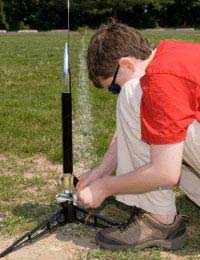Making Your Own Water Rocket

Water rockets bridge the gap between childish fun and compelling fascination. It is rocket science - but it is also ridiculously easy. This makes it a fantastic project to work on with your children. They may simply want to see how far they can get the rocket to jet through the air (probably into your neighbours garden) or you might just catch them taking a deeper interest into the science that makes water rockets so enjoyable.
What You’ll Need
To make this project, you’ll need a few parts that should all be easy to come by. Firstly you’ll need a plastic bottle. A fizzy drinks bottle is best as they’re designed to withstand up to 12 bar of pressure. Next, you’ll need a standard wine cork. Unless it’s an unusual wine bottle, the cork should fit the plastic bottle just fine. A valve is required, and this will be inserted through the cork. Any valve attached to a bicycle inner-tube should do just fine, although car tyre valves are also suitable.Aside from the materials needed to construct the rocket, you will also need a good air pump. Hand pumps are fine, but a foot pump will make the job easier, and more enjoyable. The most important aspect is that it should be easily, and securely, attachable to the air valve. You will also need a drill with a drill bit that has a diameter slightly smaller than that of the valve you’re using. Finally, a hacksaw or any saw with fine teeth will suffice.
Making Your Rocket
Firstly, if you’re using a valve from a bike inner-tube, then you will need to cut the valve away. Discard the remaining inner-tube. Using the drill-bit, drill a hole directly through the centre of the cork. Then, holding the valve up against the cork, mark off just below the level of the valve’s thread on the cork. Using the hacksaw, cut the cork down to size by sawing along the mark just made. Then press the valve through the hole, until all of the valve’s threaded head stands proud of the cork top. You may need to screw the cork in with pliers as it will be a tight fit. If this fails then you should be able to knock it in with a rubber mallet. This completes the rocket build.Safety First
Water rockets harness a considerable amount of potential energy, and this makes them dangerous. You should never stand over a pressurised water bottle. It is also advisable to wear goggles to protect your eyesight. When firing the rocket, make sure everyone is stood well back and there is nothing in its path. Water rockets can be highly dangerous if not handled with the utmost care and responsibility.Firing Your Rocket
Fill the bottle to about 1/3 full of water. Place the cork firmly onto the bottle, making sure the threaded end of the valve is facing outwards. Now, attach the pump to the valve. It’s important to make sure the bottle is nicely propped up and well supported against something, so it won’t topple over. The direction you fire the rocket is up to you, but don’t underestimate how far it will travel and always aim the rocket with safety in mind. To get the best rocket flight profile, you will undoubtedly need to experiment with the angle set up.Once you are satisfied that the rocket is at the desired angle, start pumping it with air, being careful not to position yourself over the rocket. The pressure inside the bottle will build to such a point that the friction of the cork is no longer adequate to hold it in place. Once the cork relinquishes its grip on the bottle, if everything goes according to plan, your rocket will shoot off well into the distance. The pressurised air at the head of the rocket drives the water out the back in a jet like fashion and this propels it through the air.


Re: Make Your Own Cat Litter
Why on earth is cat litter under Food Projects?? Also why is a British site giving recipes in cups?? I'm so confused.
Re: Make Your Own Cosmetics
I’m interested in starting my own makeup like but unsure how to go about it please can you help
Re: Make Your Own Cosmetics
I’m interested in having my own makeup line and I’m not sure how to start and go about it. Can you please assist me? Thank you
Re: Make Your Own Cosmetics
Hi I just wanted to get some infomation on how to start my own beauty brand and how much would it cost to make my own beauty line thank you
Re: Make Your Own Sloe Gin
I'm a newbie with sloe gin....made some fortnight ago and upon shaking just now I seem to have white bits floating around...is this…
Re: Make Your Own Tea
Hi I’m wanting to blend my own tea pack and label it in small amounts Can you do this
Re: Make Your Own Washing Powder & Fabric Conditioner
I have been making my own washing powder for about four years now and I use DriPak products, but…
Re: Make Your Own Washing Powder & Fabric Conditioner
Estelle - Your Question:What are the ingredients for making Washing powderOur Response:The detai
Re: Make Your Own Washing Powder & Fabric Conditioner
What are the ingredients for making Washing powder
Re: How to Make a Green Roof for Your Shed
I want to cover a large log cabin using a sedum blanket. Is it possible to buy the basic blanket for planting up…